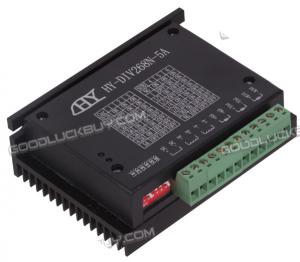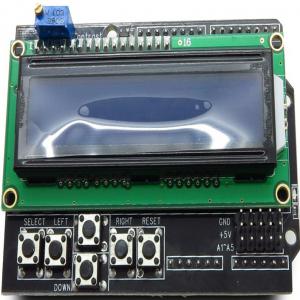Скетча для управл. оборотами ШД и вывод на LCD
- Войдите на сайт для отправки комментариев
Пнд, 26/08/2013 - 11:32
Драйвер TB6600 5A Stepper Driver
Модуль LCD Keypad Shield
Скетч использовал вот этот и демо в скетче была ошибка (ниже) обнаружил ее "leshak" за что ему большое спасибо.
37 int previous_time;
Меняем на
37 unsigned long previous_time;
прошу помощи на форуме:
- как снизить частоту оборотов до 1 обората в минуту, частота приблизительно 6 гц, в этом скетче 16,6 гц
- и поднять частоту до 2 килогерц, в этом скетче 232 гц
- шаг кнопки, 1 оборот в мин. или частота 6 гц
- при удержании кнопки более например 3 сек шаг увеличивается например 10 оборот в минуту.
Конечно хотелось бы что бы на индикаторе циферки соотвествоваль оборотам, но это не принципиально.
Вот рабочий скетч.
#include <LiquidCrystal.h>
#include <TimerOne.h>
// buttons code
#define btnRIGHT 0
#define btnUP 1
#define btnDOWN 2
#define btnLEFT 3
#define btnSELECT 4
#define btnNONE 5
// directions
#define FORWARD HIGH
#define BACKWARD LOW
// debounce time (milliseconds)
#define DEBOUNCE_TIME 200
// PINs for Pololu controller
#define PIN_STEP 2
#define PIN_DIR 3
// lookup table speed - ticks (interrupts)
const int speed_ticks[] = {-1, 600, 300, 200, 150, 120, 100, 86, 75, 67, 60, 55, 50, 46, 43};
// global variables
LiquidCrystal lcd(8, 9, 4, 5, 6, 7);
int actual_speed;
int actual_direction;
int ticks;
int tick_count;
int button;
boolean debounce;
unsigned long previous_time;
// custom LCD square symbol for progress bar
byte square_symbol[8] = {
B11111,
B11111,
B11111,
B11111,
B11111,
B11111,
B11111,
};
// string constants
char forward_arrow[] = "-->";
char backward_arrow[] = "<--";
void setup() {
// init the timer1, interrupt every 0.1ms
Timer1.initialize(100);
Timer1.attachInterrupt(timerIsr);
// init LCD and custom symbol
lcd.begin(16, 2);
lcd.setCursor(0,0);
lcd.createChar(0, square_symbol);
// pins direction
pinMode(PIN_STEP, OUTPUT);
pinMode(PIN_DIR, OUTPUT);
// initial values
actual_speed = 0;
actual_direction = FORWARD;
tick_count = 0;
ticks = -1;
debounce = false;
digitalWrite(PIN_DIR, actual_direction);
updateLCD();
}
void loop() {
// check if debounce active
if(debounce) {
button = btnNONE;
if(millis() - previous_time > DEBOUNCE_TIME) debounce = false;
} else button = read_buttons();
// if a button is pressed, start debounce time
if(button != btnNONE) {
previous_time = millis();
debounce = true;
}
// check which button was pressed
switch(button) {
case btnUP:
increase_speed();
break;
case btnDOWN:
decrease_speed();
break;
case btnLEFT:
change_direction(BACKWARD);
break;
case btnRIGHT:
change_direction(FORWARD);
break;
case btnSELECT:
emergency_stop();
break;
}
// finally update the LCD
updateLCD();
}
// increase speed if it's below the max (70)
void increase_speed() {
if(actual_speed < 70) {
actual_speed += 5;
tick_count = 0;
ticks = speed_ticks[actual_speed / 5];
}
}
// decrease speed if it's above the min (0)
void decrease_speed() {
if(actual_speed > 0) {
actual_speed -= 5;
tick_count = 0;
ticks = speed_ticks[actual_speed / 5];
}
}
// change direction if needed
void change_direction(int new_direction) {
if(actual_direction != new_direction) {
actual_direction = new_direction;
digitalWrite(PIN_DIR, actual_direction);
}
}
// emergency stop: speed 0
void emergency_stop() {
actual_speed = 0;
tick_count = 0;
ticks = speed_ticks[actual_speed / 5];
}
// update LCD
void updateLCD() {
// print first line:
// Speed: xxxRPM --> (or <--)
lcd.setCursor(0,0);
lcd.print("Speed: ");
lcd.print(actual_speed);
lcd.print("RPM ");
lcd.setCursor(13,0);
if(actual_direction == FORWARD) lcd.print(forward_arrow);
else lcd.print(backward_arrow);
// print second line:
// progress bar [##### ]
// 15 speed steps: 0 - 5 - 10 - ... - 70
lcd.setCursor(0,1);
lcd.print("[");
for(int i = 1; i <= 14; i++) {
if(actual_speed > (5 * i) - 1) lcd.write(byte(0));
else lcd.print(" ");
}
lcd.print("]");
}
// timer1 interrupt function
void timerIsr() {
if(actual_speed == 0) return;
tick_count++;
if(tick_count == ticks) {
// make a step
digitalWrite(PIN_STEP, HIGH);
digitalWrite(PIN_STEP, LOW);
tick_count = 0;
}
}
// read buttons connected to a single analog pin
int read_buttons() {
int adc_key_in = analogRead(0);
if (adc_key_in > 1000) return btnNONE;
if (adc_key_in < 50) return btnRIGHT;
if (adc_key_in < 195) return btnUP;
if (adc_key_in < 380) return btnDOWN;
if (adc_key_in < 555) return btnLEFT;
if (adc_key_in < 790) return btnSELECT;
}

Вот библиотека
ну вы тогда каждому еще и дисплей с драйвером и ардуиной разошлите почтой, и тогда все бросятся за вас все писать и делать.. нам же занятся то больше нечем... вам кажется в раздел ИЩЮ ИСПОЛНИТЕЛЯ!
Что Вы прямо так, возможно Вас сегодня обидели. Я не прошу сделать. Подсказать ведь можно?
Вроде вижу на форуме люди помогают друг другу.
Что Вы прямо так, возможно Вас сегодня обидели. Я не прошу сделать. Подсказать ведь можно?
Вроде вижу на форуме люди помогают друг другу.
да я не прям так.. щас я буду вас обижать...
пытаюсь понять в чем именно нужно помогать? что именно вы сделали сами?
вы взяли готовые детальки
соединили их проводками
залили на них пример..
а теперь хотите что бы вам этот пример доработали до того что вам нужно...
причем сами не приложили ни каких усилий что бы понять что и как в том примере работает и зачем вообще.
помогать можно когда вы попробовали сделать и у вас получилось но немного не то...
а так вы просто халявщик!
Увеличить вроде получается
057 Timer1.initialize(10); а вот уменьшить не могу
Увеличить вроде получается
057 Timer1.initialize(10); а вот уменьшить не могу
интересное решение... из серии что бы быстрей бегать, нада делать паузы между шагами короче :) ну как вариант...
смотрите функции которые у вас увеличивают и уменьшают. они так и называются.
Наверное не получится охватить весь диапазон.
Наверное не получится охватить весь диапазон.
ну скорее всего да. вы упретесь в возможности процесора... к тому же я бы еще почитал спецификации на ваш модуль.. прикинь на калькуляторе доступный диапазон...а потом только пытался выжимать из него что то.
просто судя по скечу уменьшение скорости и так происходит до нуля... и видимо для процесора это и получается 16.6 Гц..
[
#include <LiquidCrystal.h> #include <TimerOne.h> // buttons code #define btnRIGHT 0 #define btnUP 1 #define btnDOWN 2 #define btnLEFT 3 #define btnSELECT 4 #define btnNONE 5 // directions #define FORWARD HIGH #define BACKWARD LOW // debounce time (milliseconds) #define DEBOUNCE_TIME 200 // PINs for Pololu controller #define PIN_STEP 2 #define PIN_DIR 3 // lookup table speed - ticks (interrupts) const int speed_ticks[] = {-1, 600, 300, 200, 150, 120, 100, 86, 75, 67, 60, 55, 50, 46, 43}; // global variables LiquidCrystal lcd(8, 9, 4, 5, 6, 7); int actual_speed; int actual_direction; int ticks; int tick_count; int button; boolean debounce; unsigned long previous_time; // custom LCD square symbol for progress bar byte square_symbol[8] = { B11111, B11111, B11111, B11111, B11111, B11111, B11111, }; // string constants char forward_arrow[] = "-->"; char backward_arrow[] = "<--"; void setup() { // init the timer1, interrupt every 0.1ms Timer1.initialize(100); Timer1.attachInterrupt(timerIsr); // init LCD and custom symbol lcd.begin(16, 2); lcd.setCursor(0,0); lcd.createChar(0, square_symbol); // pins direction pinMode(PIN_STEP, OUTPUT); pinMode(PIN_DIR, OUTPUT); // initial values actual_speed = 0; actual_direction = FORWARD; tick_count = 0; ticks = -1; debounce = false; digitalWrite(PIN_DIR, actual_direction); updateLCD(); } void loop() { // check if debounce active if(debounce) { button = btnNONE; if(millis() - previous_time > DEBOUNCE_TIME) debounce = false; } else button = read_buttons(); // if a button is pressed, start debounce time if(button != btnNONE) { previous_time = millis(); debounce = true; } // check which button was pressed switch(button) { case btnUP: increase_speed(); break; case btnDOWN: decrease_speed(); break; case btnLEFT: change_direction(BACKWARD); break; case btnRIGHT: change_direction(FORWARD); break; case btnSELECT: emergency_stop(); break; } // finally update the LCD updateLCD(); } // increase speed if it's below the max (70) void increase_speed() { if(actual_speed < 70) { actual_speed += 5; tick_count = 0; ticks = speed_ticks[actual_speed / 5]; } } // decrease speed if it's above the min (0) void decrease_speed() { if(actual_speed > 0) { actual_speed -= 5; tick_count = 0; ticks = speed_ticks[actual_speed / 5]; } } // change direction if needed void change_direction(int new_direction) { if(actual_direction != new_direction) { actual_direction = new_direction; digitalWrite(PIN_DIR, actual_direction); } } // emergency stop: speed 0 void emergency_stop() { actual_speed = 0; tick_count = 0; ticks = speed_ticks[actual_speed / 5]; } // update LCD void updateLCD() { // print first line: // Speed: xxxRPM --> (or <--) lcd.setCursor(0,0); lcd.print("Speed: "); lcd.print(actual_speed); lcd.print("RPM "); lcd.setCursor(13,0); if(actual_direction == FORWARD) lcd.print(forward_arrow); else lcd.print(backward_arrow); // print second line: // progress bar [##### ] // 15 speed steps: 0 - 5 - 10 - ... - 70 lcd.setCursor(0,1); lcd.print("["); for(int i = 1; i <= 14; i++) { if(actual_speed > (5 * i) - 1) lcd.write(byte(0)); else lcd.print(" "); } lcd.print("]"); } // timer1 interrupt function void timerIsr() { if(actual_speed == 0) return; tick_count++; if(tick_count == ticks) { // make a step digitalWrite(PIN_STEP, HIGH); digitalWrite(PIN_STEP, LOW); tick_count = 0; } } // read buttons connected to a single analog pin int read_buttons() { int adc_key_in = analogRead(0); if (adc_key_in > 1000) return btnNONE; if (adc_key_in < 50) return btnRIGHT; if (adc_key_in < 195) return btnUP; if (adc_key_in < 380) return btnDOWN; if (adc_key_in < 555) return btnLEFT; if (adc_key_in < 790) return btnSELECT; }[/quote]
почему ARDUINO пришет:
exit status 1
Ошибка компиляции для платы Arduino/Genuino Uno.????????